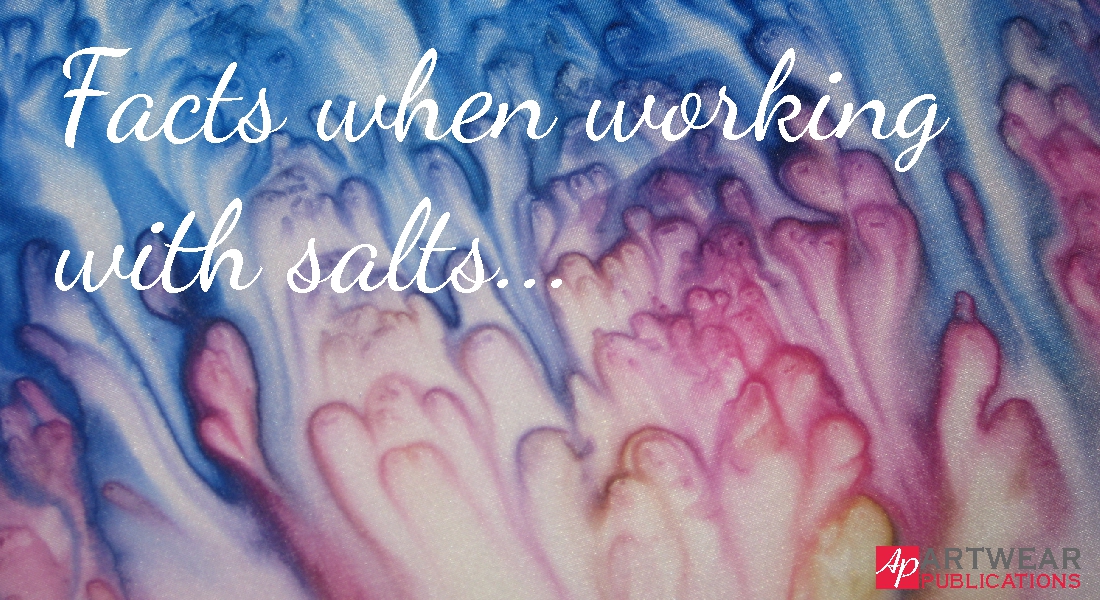
24 Feb Facts when working with salts…
Anne Mitchell is a regular contributor to Embellish magazine. Here she has some information relevant to many of her Embellish dyeing/painting fabric projects.
Working with Salt (Sodium Chloride – NaCl):
TABLE SALT / ROCK SALT / COOKING SALT / SALT FLAKES / PINK SALT / OTHER EXOTIC SALTS / POOL SALT … so many salts out there in the marketplace!
These are all Sodium Chloride (NaCl) and the size and shape of the crystal will determine the markings when used in fabric designing techniques. Pool salt is the same type of salt as all the others, but simply not refined to food grade. I love the randomness of the size of pool salt. However, if you are reluctant to invest in a large bag of it, you can create your own random-sized crystals by putting some rock salt in a plastic bag and hitting it – gently! – with a hammer.
I’m sure you are familiar with the salt shaker in your pantry clogging in wet or humid weather? I remember my grandmother putting a few grains of rice in the shaker to absorb the moisture and prevent the frustration! Did that work? I really don’t remember after all these years … but …
The fact is that whenever we are using any of these salts in our fabric designing, they will draw in moisture from the atmosphere during rainy weather or high humidity, or even a sea breeze. It is also well known that salting techniques will not create good results when working with traditional fibre-reactive dyes in wet weather as the salt remains too wet for the grains to pull the dye, so they will sit in puddles. When using paint formulations like Liquid Radiance, the colours will create the desired textures perfectly, just taking a little longer to work their magic. Remember, any moisture that remains in the fabric after the salt markings have formed must be dried completely before rinsing to ensure that the colour is no longer active and the dampness or clamminess we feel is only from the salt absorbing atmospheric moisture. [See “Removing the Salt …”]
Working with Epsom Salt (Magnesium Sulphate – MgSO4):
The name Epsom Salt comes from the town of Epsom in Surrey, England, where it was originally discovered, and named as a salt because of its appearance. However, it has a totally different chemical structure to table salt. The benefit for its use in fabric designing is that it does not draw in moisture from the atmosphere as food salts do. I like to refer to it as my ‘goof proof’ salt! It is also safe for use in and around the home for that relaxing salt bath.
Removing the Salt:
When fabric is completely dry, scrape the salt towards the middle of the fabric and pour the salt back into the container. If salt feels damp, place it on a baking tray in a hot oven for 15 to 20 minutes, then let it cool before returning it to its container.
When the salt crystals have been removed, the salty residue in the fabric must be rinsed out. In rainy, stormy, or humid weather, the remaining saltiness will continue to absorb moisture from the atmosphere, making the fabric feel clammy. To be sure the colours are completely dry before rinsing, put the fabric on the clothes line if sunny, or use a hair dryer to blow it dry. Do not put it in a clothes dryer as this can add saltiness to the surface in the dryer which is difficult to remove and will transfer to other items in the dryer.
VITAL: Salt MUST be rinsed from the fabric completely to prevent it getting into the mechanism of your sewing machine, or onto your ironing board and iron. Saltiness will travel from surface to surface of fabrics, boards and work sheets if you are not careful when using it. Rinse all items used in salting techniques to avoid salt going into places where you don’t want it!
Photography Anne Mitchell, Alan Mitchell


No Comments